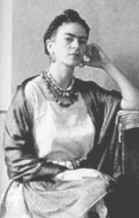|
|

|
Frida Kahlo
Painter
Mexico
|
Frida Kahlo recounted the remarkable story of her life through her paintings. She was born in 1907 on the outskirts of Mexico City, but revised her birth date to 1910 in part to coincide with Mexican Revolution and the birth of modern Mexico. The birth of her nation thus became simultaneous with her own birth and she identified Mexico's struggle for national identity with her own internal struggles. Between 1926 and her death at the age of 47, in 1954, she created approximately 150 works of art, producing some of the most original and compelling imagery of the 20th century.
Like her new country, Kahlo was born of two great cultures: Judeo-Christian heritage of her European-born father and prehispanic Indian heritage of her Mexican-born mother. To reconcile these different cultures in her art, Kahlo intertwined emblematic images from each with autobiographical symbols, producing a body of work that wove together the cultural and personal.
In her paintings, it is common to find a self portrait or scene from her life portrayed in the simple, unschooled painting style of Mexican retabo paintings (complete with dedicatory inscriptions) combined with echoes of Christian pietas and martyrdom of saints. Like Mexico itself, Kahlo's art is a hybrid of cultural influences, distinguished by its idiosyncratic mixture of traditions.
Kahlo once remarked that she suffered two great accidents in her life: One was a bus accident and the other was marrying Diego Rivera. In 1925, at the age of 18, Kahlo was severely injured in a bus accident that permanently damaged her spinal cord and foot. She is said to have undergone more than 32 operations and endured long periods of convalescence.
Kahlo began painting while recuperating from this injury. Her mother ordered a special easel that she could use in bed and her father, a distinguished photographer, gave her paints and brushes. Initially, Kahlo painted subjects that were close at hand: Her relatives, friends and herself.
In 1929, she married the famous Mexican mural painter, Diego Rivera; She was 22 and he was 42. Her parents said it was like an elephant marrying a dove.
Their stormy relationship was the stuff of tabloids as well as the subject of many haunting paintings. Traumas of her marriage, her chronic pain, and especially her inability to have a child promoted many of Kahlo’s finest works. Her greatest subject was herself, which she painted repeatedly throughout her career, always with an unflinching intensity that remains challenging, confrontational and unforgettable.
A legend in her own time, Frida Kahlo’s life has recently taken on mythic proportions. Whether because her self-portraits resemble icons, or because the mythology surrounding her life resembles that of a martyred saint, Frida has become a contemporary cult figure.
The growing audience for her work matches the popularity of her story. In the late 1970s exhibitions were presented in United States, Europe and Mexico, and an authorities biography and a catalogue of complete works were published in 1980s. Women especially have been drawn to Kahlo’s intense portrayal of female subjects and her personal determination to paint in spite of great physical paint.
Diego Rivera summarized the power and significance of Kahlo’s art in 1943: “Frida is the only example in the history of art of an artist who tore open her chest and heart to reveal the biological truth of her feelings … a superior painter and the greatest proof of renaissance of the art of Mexico.”
One could see the evolution of Kahlo’s works from her earliest watercolors to her last great self-portraits. In the years following Mexican Revolution, Kahlo was one of many artists to participate in a nationalistic celebration of indigenous arts and customs.
|
|
|
